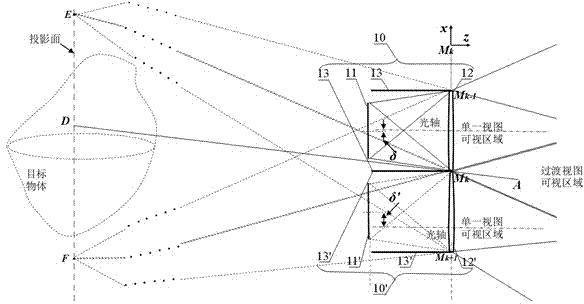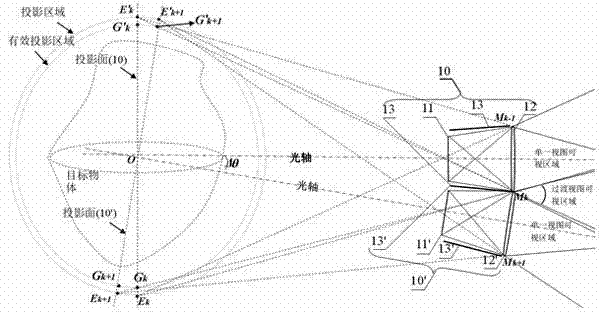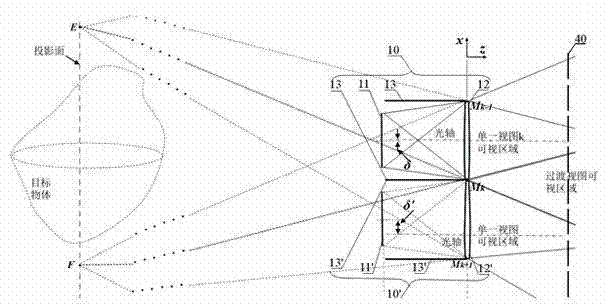Light complementary splicing technology for generating space gradual transition view and three-dimensional display system based on light complementary splicing technology
A technology for generating space and views, applied in optics, optical components, instruments, etc., can solve problems such as affecting display quality, achieve continuous motion parallax, and improve display effects.
- Summary
- Abstract
- Description
- Claims
- Application Information
AI Technical Summary
Problems solved by technology
Method used
Image
Examples
Embodiment 1
[0049] A three-dimensional display system constructed according to type I steps adopts type I limited projection units 10 in a linear arrangement (the distance between the display device 11 and the projection lens 10 is smaller than the focal length of the projection lens 10). Such as figure 1 As shown, two constrained projection units 10 and 10 ′ arranged along a one-dimensional linear direction are taken as an example for illustration. The limited projection unit 10 includes: a projection device 11 , a projection lens 12 , and a light blocking plate 13 . The limited projection unit 10' includes: a projection device 11', a projection lens 12', and a light blocking plate 13'. The two restricted projection units 10 and 10' are arranged parallel and adjacent to each other along the x direction. When the thickness of the light barrier is relatively small, it can be considered that the projection lenses 12 and 12' share a side point M k ,Pass M k The dot light barriers 13 an...
Embodiment 2
[0054] A three-dimensional display system built according to Type I steps adopts Type I limited projection units 10 arranged in a circular manner (the distance between the display device 11 and the projection lens 10 is smaller than the focal length of the projection lens 10). Such as figure 2 As shown, here we take two constrained projection units 10 and 10 ′ arranged along a one-dimensional circumferential direction as an example for illustration. The limited projection unit 10 includes: a projection device 11 , a projection lens 12 , and a light blocking plate 13 . The limited projection unit 10' includes: a projection device 11', a projection lens 12', and a light blocking plate 13'. The two restricted projection units 10 and 10' are surrounded by O The circle with the point as the center is arranged adjacent to each other, and their relative deflection angle is θ . When the thickness of the baffle is relatively small, it can be considered that the projection lenses ...
Embodiment 3
[0059] The three-dimensional display system is built according to the steps of type III by adopting the type I limited projection unit 10 arranged in a straight line (the distance between the display device 11 and the projection lens 10 is smaller than the focal length of the projection lens 10 ). Such as image 3 As shown, two constrained projection units 10 and 10 ′ arranged along a one-dimensional linear direction are taken as an example for illustration. The limited projection unit 10 includes: a projection device 11 , a projection lens 12 , and a light blocking plate 13 . The limited projection unit 10' includes: a projection device 11', a projection lens 12', and a light blocking plate 13'. The two restricted projection units 10 and 10' are arranged parallel and adjacent to each other along the x direction. When the thickness of the light barrier is relatively small, it can be considered that the projection lenses 12 and 12' share a side point M k ,Pass M k The dot ...
PUM
 Login to View More
Login to View More Abstract
Description
Claims
Application Information
 Login to View More
Login to View More - R&D
- Intellectual Property
- Life Sciences
- Materials
- Tech Scout
- Unparalleled Data Quality
- Higher Quality Content
- 60% Fewer Hallucinations
Browse by: Latest US Patents, China's latest patents, Technical Efficacy Thesaurus, Application Domain, Technology Topic, Popular Technical Reports.
© 2025 PatSnap. All rights reserved.Legal|Privacy policy|Modern Slavery Act Transparency Statement|Sitemap|About US| Contact US: help@patsnap.com



